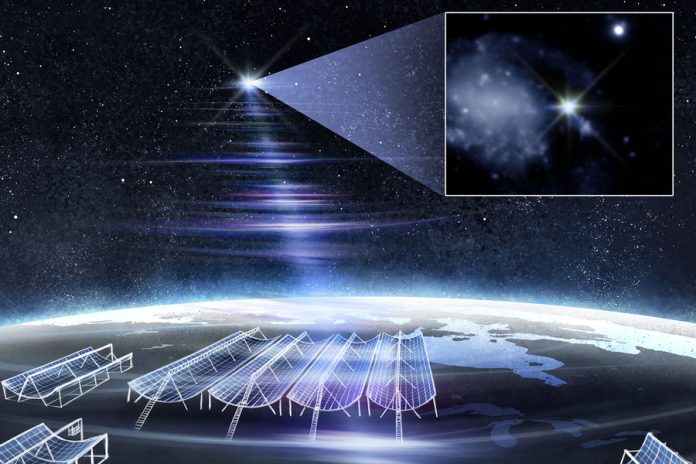
For just a split second, a mysterious flash of radio energy lit up the sky so brightly that it briefly outshone every radio source in its galaxy.
Astronomers have now confirmed that this was the brightest fast radio burst (FRB) ever recorded, detected from a galaxy just 130 million light-years away in the constellation Ursa Major.
The extraordinary signal has earned the nickname RBFLOAT, short for “radio brightest flash of all time.”
Fast radio bursts are still one of astronomy’s great mysteries.
They last only a few milliseconds, yet they can release more energy than our Sun emits in days or even weeks. Since the first FRB was discovered in 2007, astronomers have cataloged thousands of them, but the exact cause remains unknown.
The leading suspects are magnetars, exotic remnants of dead stars with magnetic fields billions of times stronger than Earth’s.
The new burst stands out not just for its incredible brightness but also for how close it is by cosmic standards.
At just 130 million light-years away, this FRB gives scientists one of their best opportunities yet to examine the phenomenon in detail.
“Cosmically speaking, this fast radio burst is just in our neighborhood,” said MIT physicist Kiyoshi Masui. “That means we can study it with much greater precision than most other FRBs.”
The detection was made possible thanks to a major upgrade to CHIME, the Canadian Hydrogen Intensity Mapping Experiment, located in British Columbia. CHIME is a massive radio telescope array originally designed to map hydrogen across the universe, but since 2018 it has become one of the most productive tools for detecting FRBs. Until recently, however, CHIME had one major limitation: it could detect bursts but not pinpoint their exact location in the sky.
That changed with the addition of CHIME Outriggers, three smaller telescopes spread across North America. By working together with the main CHIME array, these stations create a continent-sized observatory that can not only detect bursts but also triangulate exactly where they come from. MIT graduate student Shion Andrew described the improvement with an analogy: “Localizing an FRB is like trying to figure out not just which tree a firefly came from, but which branch it’s sitting on.”
On March 16, 2025, CHIME picked up an incredibly bright flash of radio waves. At first, astronomers weren’t sure if it was a genuine cosmic event or interference from something on Earth, like a cell tower.
But the Outriggers quickly confirmed it was real and traced it to NGC 4141, a spiral galaxy in Ursa Major. Follow-up observations revealed that the burst came from the galaxy’s outer edge, just outside a region where new stars are being born.
This location could provide a clue about its origin. Magnetars are thought to form in star-forming regions, where young, massive stars die and collapse.
Finding an FRB just outside such a region suggests the source may be a slightly older magnetar that has drifted away from where it was born. “These are mostly hints,” Masui explained. “But the precise localization of this burst is letting us explore how old an FRB source could be.”
Another intriguing aspect of this FRB is that it appears to be a one-time event. Some FRBs repeat, flashing unpredictably, and a few even pulse in rhythmic patterns.
But a look back through CHIME’s six years of data showed no sign of this source repeating. That makes it especially valuable for testing theories about whether repeating and nonrepeating bursts are caused by different objects or processes.
The discovery highlights how far FRB science has come in less than two decades. With CHIME and its Outriggers, astronomers are now able to localize bursts with remarkable precision, and they expect to pinpoint hundreds more every year.
Each detection brings researchers closer to unraveling the mystery of these cosmic flashes. As MIT postdoctoral researcher Adam Lanman noted, “We’re starting to see the diversity of environments FRBs come from, and that’s key to solving the puzzle.”
For now, RBFLOAT remains the record holder: the brightest fast radio burst ever detected, blazing a trail for astronomers to follow in their quest to understand one of the universe’s strangest signals.



